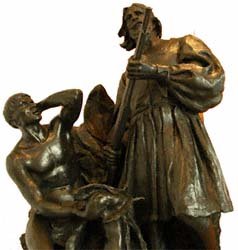

| Home » Rio for Beginners » Native Brazilian Indians |
 |
 Way
before the Portuguese ever set foot in Brazil, the land was home to a
number of indigenous peoples. Most Brazilian Indians are part of the
Tupi-Guarani family. The ones that aren't, are usually referred to as
Tapuias. They spoke hundreds of different dialects, and were spread all
along the Brazilian coast.
Way
before the Portuguese ever set foot in Brazil, the land was home to a
number of indigenous peoples. Most Brazilian Indians are part of the
Tupi-Guarani family. The ones that aren't, are usually referred to as
Tapuias. They spoke hundreds of different dialects, and were spread all
along the Brazilian coast.
In addition to hunting, fishing and collecting fruit, the Indians planted beans, corn, pumpkins, and manioc. To clear the land for farming they would first burn the forest down. Whenever the land started to get poor they would move on to another spot, burn another forest down, and start from scratch.
Trading of goods among different tribes was not common, they produced
only enough to survive. Wars were very common. Most tribes had warriors
who were masters at the bow and arrow, and used other tools such as the
zarabatana - a flute-like instrument with a poisonous dart, also used
for hunting.
While Indians were no match to the weapons used by the Portuguese, some tribes had rituals that virtually terrified the Europeans. Up North, in the Amazon, there was a tribe that the technique of shrinking skulls to the size of a tennis ball! Anthropophagic rituals were described by those who lived to tell.
Hans Staden, a German mercenary, was captured by Indians, somehow spared, and later rescued. He lived for three years among Tupinambá Indians, between 1554 and 1557. His story was turned into a book, with all the gory details. The whole tribe was involved in the ritual, as the idea was that eating a brave enemy would give you some of his power.
The prisoner was treated more like a guest of honor than anything
else. When he arrived he had to cry out something like "I, thy
food, have arrived." Later he was offered a daughter or sister
of his captor, and was allowed to walk freely - escaping would be
a dishonor.  It
could could take months, sometimes years before the final sentence was
executed. All body parts were eaten, the blood was reserved to the
children. Bones were used in ornaments or to make flutes, and the skull
was displayed as a trophy on the door of the captor's home.
It
could could take months, sometimes years before the final sentence was
executed. All body parts were eaten, the blood was reserved to the
children. Bones were used in ornaments or to make flutes, and the skull
was displayed as a trophy on the door of the captor's home.
These tribes did not have the notion of a country, and they were in constant fights with each other. They were baffled yet fascinated by the new visitors. In addition to exotic birds like parrots and toucans, the funny-dressed guys were also interested in pau-brasil. This native wood with a deep red color was used to dye fabrics in the XVI century, way before artificial pigments were created. In exchange they offered metal tools, mirrors, weapons, and other civilized goods.
Rio de Janeiro was home to two different tribes that had been enemies for centuries. The first ones to call the attention of Europeans were the Tupinambás. They soon learned to trade with the French, and their influence in Europe may have been greater than you can imagine. From them was born the myth of the good savage, that would later inspire Illuminist ideals of liberty, equality and fraternity and in the XVIII century.
The French sent Vice-Admiral Nicolas de Villegaignon to found the
Antartic France in Rio, in 1554.  He
made an agreement with Tupinambá Chief Cunhambebe, and they lived in
relative peace for almost ten years. Their alliance with the French
would seal their fate when the Portuguese decided to reclaim Rio from
their European competitors.
He
made an agreement with Tupinambá Chief Cunhambebe, and they lived in
relative peace for almost ten years. Their alliance with the French
would seal their fate when the Portuguese decided to reclaim Rio from
their European competitors.
The Tamoios sided with the Portuguese, and would help them combat and enslave the enemy tribe. The Temiminós also helped the Portuguese defeat the French in 1567, headed by Chief Araribóia. The Indians did not have any protection against diseases that were common among the Europeans, though. Many died in epidemics, others were enslaved, and many were catechized by Catholic priests.